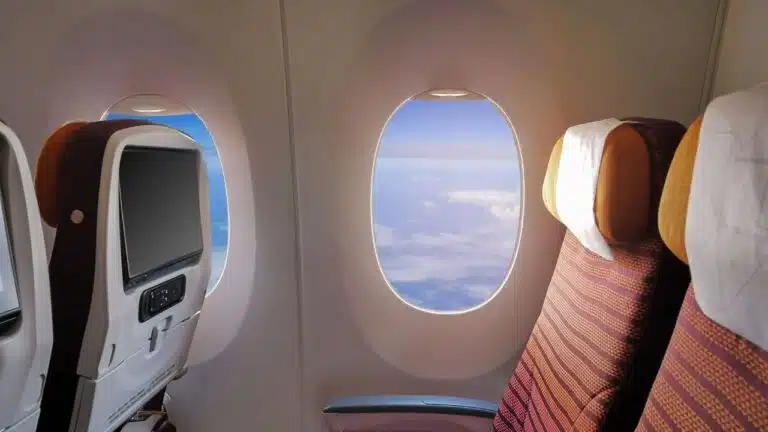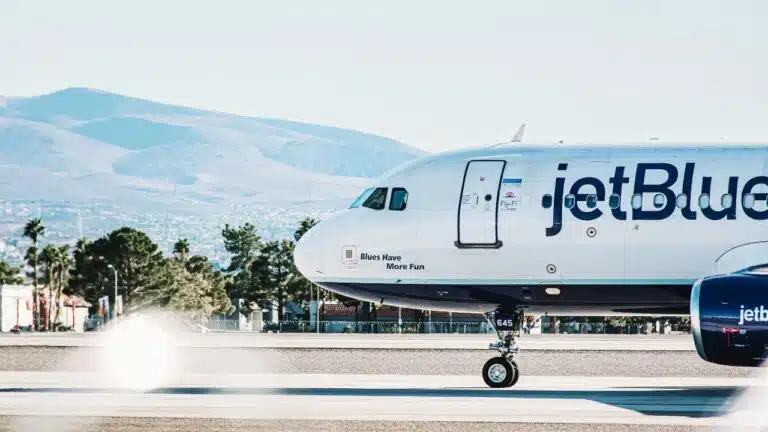Recognized as one of the best airlines in the US, JetBlue tops the charts for excellent customer experiences in economy and business class. But how does it compare to one of the oldest airlines in the world? Delta has been around since the 1920s and has often been the national and global leader of the skies. Its awards range from excellent service to outstanding innovation. So, when it comes time to book your next flight, you may be stuck wondering who to choose: the young upstart or the tried-and-true champion? If you can’t decide between JetBlue Airways vs. Delta Air Lines, don’t fret. Here’s what you need to know to choose the right airline for you.
Table of Contents
- Is JetBlue Better Than Delta?
- JetBlue vs. Delta Airlines: Hubs and Destinations
- JetBlue vs. Delta Airlines: Fare Option
- JetBlue vs. Delta Airlines: Additional Fees
- JetBlue vs. Delta Airlines: Seat Comfort and Leg Room
- JetBlue vs. Delta Airlines: Inflight Entertainment
- JetBlue vs. Delta Airlines: Loyalty Program
- JetBlue vs. Delta Airlines: Reliability
- JetBlue vs. Delta Airlines: Safety Rating
- JetBlue vs. Delta Airlines: Credit Card
- Next Vacay Finds You the Cheapest Deals on JetBlue, Delta, and Everything in Between
Is Jetblue Better Than Delta?
In the battle of airline heavy-hitters, JetBlue shines as a clear favorite for many who value a comfortable flight with spacious seating and hours of entertainment at the ready. However, for those looking for a global network of flights and earning opportunities, Delta is the undisputed champ.
JetBlue offers one of the best economy and business class experiences among US airlines. This makes it stand out among other low-cost carriers. However, when stacked up against an old favorite like Delta, there are some obvious areas where the New York-based airline comes up short. So, the final say will come down to the experience and rewards you want out of your next flight.
JetBlue vs. Delta Airlines: Hubs and Destinations
Delta Air Lines comes out on top for destinations and international flights.
While JetBlue’s destination list is impressive, its presence isn’t nearly as strong as Delta’s on the global market. Delta flies to more cities domestically and internationally with more than double the destinations JetBlue offers. On top of that, Delta’s partnership with SkyAlliance means Delta flyers enjoy even more global connections.
JetBlue
JetBlue is headquartered out of Long Island, New York, and bills itself as a budget airline. Like most low-cost carriers, most of its flights center around destinations in the US. However, that doesn’t mean you can only fly domestically with the airline. JetBlue operates flights to a handful of international destinations in Latin America and the Caribbean. The New York-based airline also services long-haul flights to and from London. Of the more than 100 cities that JetBlue flies to, it has six major focus cities:
- Boston
- Fort Lauderdale
- Los Angeles
- New York
- Orlando
- San Juan, Puerto Rico
Delta
With its headquarters located in the busiest airport in the United States in Atlanta, Georgia, Delta bills itself as the airline meant to connect the world. No one can argue it’s not doing a fair job of it, either. The airline’s global presence is massive, with over four thousand daily flights and more than 275 destinations on six continents. Consequently, Delta can provide its customers with plenty of choices, including some of the hottest global destinations, some of which are reflected in key Delta hubs and markets:
- Amsterdam
- Atlanta
- Boston
- Detroit
- London-Heathrow
- Los Angeles
- Mexico City
- Minneapolis-St. Paul
- New York
- Paris-Charles de Gaulle
- Salt Lake City
- Seoul-Incheon
- Tokyo
JetBlue vs. Delta Airlines: Fare Options
Again, the winner here is Delta Air Lines. Comparing JetBlue fares to Delta fares, the former’s are more affordable. However, the range of experiences is limited, with only one premium experience offered on select routes. On the other hand, Delta offers more premium cabin options in and outside the US.
JetBlue
JetBlue offers customers five different fare types.
- Blue Basic
- Blue
- Blue Plus
- Blue Extra
- Mint
Blue Basic, Blue, Blue Plus, and Blue Extra are all considered Main Cabin fares, so the inflight experience is comparable. Where they differ is in additional perks. While Blue Basic is the no-frills fare, the remaining ticket types include benefits ranging from carry-on bags and no fees for changes or cancellations to earlier boarding and speedier check-in.
The Mint experience is the only premium cabin fare offered by JetBlue. Mint covers all the benefits of Main Cabin with business-class luxury and perks like additional privacy and lie-flat seats.
Delta
Delta customers have their choice of six different fare types.
- Basic Economy
- Main Cabin
- Comfort Plus
- First Class
- Premium Select
- Delta One
However, the availability of these fare types depends on the route customers are flying.
Most Main Cabin fares are available on every flight, regardless of the route. This covers Basic Economy, Main Cabin, and Comfort Plus. Unlike JetBlue, the inflight experience differs based on the fare chosen. So, along with added perks like drinks and more baggage, some customers get early boarding and more legroom depending on if they’ve chosen Basic Economy or Delta Comfort Plus.
Regarding premium experiences, Delta offers three different options. First Class is available on domestic flights, while Premium Select and Delta One are available on select long-haul flights. Because these are luxury fare options, customers can expect luxury perks, including more space, expedited services, chef-curated meals, and personal flight attendants.
JetBlue vs. Delta Airlines: Additional Fees
In a close race, Jetblue manages to edge past Delta to come out on top for the cheaper additional fees. It comes down to their baggage and seating selection fees. While JetBlue charges roughly $40 per flight for a checked bag and selected seat, Delta charges approximately $59 for the same items.
JetBlue
Across the board, JetBlue charges few additional fees except for Blue Basic travelers. The airline’s cheapest fare excludes a carry-on bag option while including a change/cancellation fee of $100 for most flights. All other fare types see no fees for carry-on bags or changes/cancellations.
While the checked bag fee is slightly higher than Delta at $35 for a first bag, where JetBlue edges out the competition is its seat selection. Advance seat selection is free for all fares except Blue Basic, which can cost as little as $5 one-way.
Pro-Tip: Mosaic status qualifies members for a free carry-on, two free checked bags, and free same-day switches. Or, get a JetBlue credit card to get your first checked bag free.
Delta
Unlike the New York-based airline, Delta allows a free carry-on for all fare types, including Basic Economy. However, while JetBlue’s basic option can be changed or canceled, Delta only allows customers to cancel a Basic Economy ticket for a $99 fee. This means Delta flyers must cancel and then re-book if still planning to fly.
Delta almost comes out on top with a cheaper checked bag fee of $30. But, where flyers will feel the brunt of the difference in additional fees between JetBlue vs. Delta is the seat selection fee. While Delta does offer seat selection as low as $10, the average cost of selecting a seat falls around $29 per flight.
Pro-Tip: Medallion members and flyers with a qualifying Delta credit card can fly with a free checked bag.
JetBlue vs. Delta Airlines: Seat Comfort and Leg Room
This is an easy win for the New York-based airline. If the most crucial factor in your JetBlue vs. Delta debate is comfort, then it’s not even a competition. JetBlue prides itself on being the most comfortable US airline and easily outshines Delta’s standard performance in this arena.
JetBlue
The nice thing about flying JetBlue is that your inflight experience stays the same in the Main Cabin. That extends to seat comfort too. JetBlue offers the widest seats on a domestic airline and several inches of extra legroom. While the global standard sits at 31 inches, JetBlue offers up to 34 inches. That may not seem like a lot on paper, but when cruising at 30,000 feet, those extra inches quickly add up. And the result is a more comfortable ride.
In addition to their standard seat legroom, which is pretty stellar, JetBlue also offers an add-on called Even More Space. This add-on can be purchased alongside any Main Cabin fare, including Basic Economy. The upgrade puts flyers at the front of the cabin with up to an impressive 41 inches of legroom.
Delta
Compared to JetBlue’s standard policy on comfort, Delta Air Lines falls a bit short. A regular Main Cabin fare only affords passengers a seat pitch of 31-32 inches.
However, Delta does offer an upgrade option for more legroom called Delta Comfort Plus. Unlike JetBlue’s Even More Space add-on, this is an entirely separate fare type. Passengers can buy or upgrade to Comfort Plus, provided they have a regular Main Cabin ticket and not Basic Economy.
Comfort Plus also comes with other add-ons, but if you’re looking at buying it solely for the legroom, it still pales in comparison to JetBlue. Offering a measly three inches of additional legroom, it offers barely more than a standard JetBlue seat and nothing close to JetBlue’s Even More Space seating.
JetBlue vs. Delta Airlines: Inflight Entertainment
Both airlines put in the work to offer a best-in-class inflight experience. However, for the absolute best experience, JetBlue’s seatback screens and free Wi-Fi have to solidify it as the top choice. Against features like that, Delta Air Lines comes in at a close second and offers an excellent option for people looking to fly somewhere JetBlue doesn’t offer service.
JetBlue
JetBlue has a lot going for it, and one of the areas where that’s abundantly clear is inflight entertainment. JetBlue is the only domestic carrier to guarantee a seatback screen with every seat and, with that, the option to watch live TV, new releases, and more on every flight.
Like most airlines, JetBlue also offers Wi-Fi. However, unlike other airlines, it’s free, allowing you to play on your own devices, message friends on the ground, and even scroll through your email.
Mint flyers get an upgraded experience with a bigger screen, wireless chargers, in-seat power, and more to make the hours fly.
Delta
The inflight entertainment on a Delta flight differs slightly depending on your route and plane model. While not every Delta flight has seatback entertainment, Delta has updated its fleet, so over 90 percent do. Consequently, your odds of flying with are better than flying without.
And when you do fly with it, Delta Studio provides over 1,000 hours of free entertainment. Unfortunately, if you want to connect to the web while in the air, you’ll have to fork over some cash. Unlike JetBlue, Delta’s Wi-Fi isn’t free, but on flights powered by Viasat, Delta flyers can access high-speed internet at 30,000 feet for just $5 per flight. And while not exactly free, it’s much cheaper than the competition.
JetBlue vs. Delta Airlines: Loyalty Program
The clear winner here is Delta Airlines. Both airlines have non-expiring points and allow rewards program members to redeem miles with partner carriers. However, Delta’s extensive network and global partners make it almost impossible to beat.
JetBlue
JetBlue’s TrueBlue loyalty program includes two statuses: member and Mosaic. Basic membership means two times points booking on the website or app and the ability to pool points with friends and family. Compare that to its elite Mosaic status, which has a slew of added benefits like three times points, two free checked bags, and complimentary inflight alcoholic beverages. Some of these perks even carry over to American flights.
JetBlue has an excellent earning policy with an easy redemption program but falls short in its rewards value and destination coverage, which doesn’t come close to Delta’s.
Delta
SkyMiles is the airline’s premier loyalty program. Though it includes a basic membership status, the four elite status tiers have the most notable benefits, including complimentary upgrades, waived baggage fees, priority boarding, and much more.
One of the biggest advantages of Delta’s SkyMiles program is that miles can be redeemed on Delta flights and SkyTeam Alliance flights, which widens its reach to over twenty airlines. On top of earning miles with travel purchases, members can also earn on everyday purchases with any of the seven Delta SkyMiles credit cards the airline offers.
Like JetBlue, Delta makes it easy to earn points and lets you work toward elite status without flying. However, the one big caveat to redeeming points is Delta’s dynamic redemption system, which fluctuates based on demand.
JetBlue vs. Delta Airlines: Reliability
Delta again takes the crown here. No one likes having their travel plans pushed back, yet delayed and canceled flights seem an unavoidable hazard. However, if you’re looking to cut down on delays during your future travels, Delta is the undisputed king of reliability, with the fewest delays, cancellations, and luggage mishaps.
JetBlue
Jetblue has been fairly reliable in the past, with over 70 percent of its flights arriving on time. However, the airline has been plagued by delays in 2022, partly due to staffing issues, which has caused the airline to shoot up to a staggering 34 percent of flights being delayed or canceled entirely. That may leave you in a pretty tough spot for your trip when you’re scrambling to make adjustments.
Delta
Opposite one of the worst performing airlines in JetBlue, Delta Airlines comes away with the best record for on-time arrivals at over 80 percent, according to the Bureau of Transportation Statistics report. And based on a study done by WalletHub, Delta also had the fewest instances of mishandled luggage and denied boardings. So, regarding reliability, there’s truly no better option than flying Delta Air Lines.
JetBlue vs. Delta Airlines: Safety Rating
Neither JetBlue nor Delta is ranked as the top airline for safety in the US or abroad. However, Delta manages to squeak by with a spot in the top twenty of the safest airlines in the world, claiming a meager victory over the New York-based airline and positioning Delta as the safest major US carrier to fly with on your next trip.
JetBlue
While JetBlue didn’t make the cut for the safest global airline, the New York-based airline did make up ground among the top ten low-cost carriers. With no fatal crashes in its history, a reliable aircraft fleet, and a rigorous response to COVID-19 compliances, Jetblue ranked fifth best in overall safety.
Delta
As one of the oldest airlines still in existence today, Delta has often led the charge on safety initiatives. It was the first to implement X-ray inspections of its aircraft in 1954 and install defibrillators onboard in 1998. Despite its age and size, Delta has had few recent incidents with its massive fleet, and with plans for over 200 new aircraft to reduce the age of its fleet even further by 2025, Delta reigns as one of the safest major airlines in the US.
JetBlue vs. Delta Airlines: Credit Card
Delta comes away with its final clear win here. As no slouch in the rewards department, it stands to reason they’d have the credit cards to match. On top of offering several more credit cards than JetBlue, several Delta SkyMiles cards rank among the top cards for travelers.
JetBlue
The New York-based airline offers three credit cards, two personal and one business, with various benefits. While all cards include no foreign transaction fees and inflight savings, some highlight free checked bags and anniversary bonus points. However, the biggest drawback to JetBlue’s cards is that none can be considered a premium travel card.
JetBlue Card ($0 annual fee): No annual fee makes this card more attractive upfront, but it comes with few perks other than three times points on JetBlue purchases and $10,000 bonus points after spending $1,000 in the first 90 days.
JetBlue Plus Card ($99 annual fee): Earn 40,000 bonus points when you spend $1,000 and pay the annual fee within 90 days.
JetBlue Business Card ($99 annual fee): Limited-time offer of 80,000 bonus points and a $99 credit after spending $2,000 in 90 days.
Delta
Every Delta card except for the Delta SkyMiles Blue American Express Card is available for personal and business travelers. On top of great introductory offers, cards also come with excellent perks like lounge access, status boost, and fee credits for Global Entry or TSA Pre-Check.
Delta Personal Cards
Delta SkyMiles Gold American Express Card ($0 intro annual fee; then $99 annual fee): Earn 40,000 bonus miles after spending $2,000 in the first six months.
Delta SkyMiles Platinum American Express Card ($250 annual fee): Earn 50,000 bonus miles and 5,000 Medallion Qualification Miles (MQMs) after spending $3,000 in the first six months.
Delta SkyMiles Reserve American Express Card ($550 annual fee): Earn 50,000 bonus miles and 10,000 MQMs after spending $5,000 in the first six months. Reserve cardholders also get complimentary access to the Delta Sky Club.
Delta SkyMiles Blue American Express Card ($0 annual fee): Earn 10,000 bonus miles after spending $1,000 in the first six months.
Delta Business Cards
Delta SkyMiles Gold Business American Express Card ($0 intro annual fee; then $99 annual fee): Earn 50,000 bonus miles after spending $2,000 in the first three months.
Delta SkyMiles Platinum Business American Express Card ($250 annual fee): Earn 60,000 bonus miles and 5,000 MQMs after spending $3,000 in the first three months.
Delta SkyMiles Reserve Business American Express Card ($550 annual fee): Earn 60,000 bonus miles and 10,000 MQMs after spending $4,000 in the first three months.
Next Vacay Finds You the Cheapest Deals on JetBlue, Delta, and Everything in Between
Don’t get caught up in the drama of Jetblue vs. Delta. It doesn’t matter if you fly JetBlue, United Airlines, or Air France—you want the best flight at the lowest price possible. Next Vacay can make it happen. With a dedicated team of deal hunters at the ready, you don’t even have to lift a finger; the deals come straight to you.
With deals delivered every week, you can save big on flights with all your favorite airlines to all your favorite destinations. Sign up for the Next Vacay newsletter and start flying smarter, not harder. Fly with Next Vacay.



